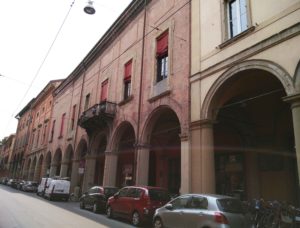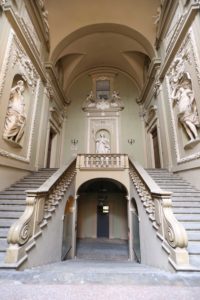 From the outside, the Palazzo Pallavicini is rather inconspicuous: bricks and arcades are no rarity in Bologna. Only the size and the prominent balcony are giving a hint that the building might have some importance. Many Bolognese people and visitors might have passed thoughtless. They will be surprised to learn about the inside and the history, since it is now open to the public after years in oblivion. Nevertheless, behind the facade slumbered a treasure.
From the outside, the Palazzo Pallavicini is rather inconspicuous: bricks and arcades are no rarity in Bologna. Only the size and the prominent balcony are giving a hint that the building might have some importance. Many Bolognese people and visitors might have passed thoughtless. They will be surprised to learn about the inside and the history, since it is now open to the public after years in oblivion. Nevertheless, behind the facade slumbered a treasure.
The “Piano Nobile” (noble floor) spread over 1775 square meters, with extremely high ceilings with painted stucco decorations, bas-reliefs and frescos mainly from the late 18th century. Originally build in the 15th century; prominent Bolognese families, who decorated it according to their taste and at the current fashion, owned the palace. Even higher social glory came to the building, when the Count Marshal Gian Luca Pallavicini became resident at the place in 1765.
 Due to his connection to the court of the House of Habsburg as high diplomat of the Austrian empire, he invited illustrious people to his banquets and concerts. Even the 14-year-old musical boy wonder Wolfgang Amadeus Mozart performed here. In 1768 Maria Carolina of Austria, daughter of the empress Maria Theresa stopped at the palace on her way to marry Ferdinand of Bourbon in Naples. The ceiling fresco “L’imperatrice Maria Teresa d’Asburgo come Cibele Madre di tutti i popoli” (The empress Maria Theresa from Habsburg as Cybele Mother of all nations) by Pietro Fabbri witnesses the close relationship between Count Marshal Gian Luca Pallavicini and the royal family.
Due to his connection to the court of the House of Habsburg as high diplomat of the Austrian empire, he invited illustrious people to his banquets and concerts. Even the 14-year-old musical boy wonder Wolfgang Amadeus Mozart performed here. In 1768 Maria Carolina of Austria, daughter of the empress Maria Theresa stopped at the palace on her way to marry Ferdinand of Bourbon in Naples. The ceiling fresco “L’imperatrice Maria Teresa d’Asburgo come Cibele Madre di tutti i popoli” (The empress Maria Theresa from Habsburg as Cybele Mother of all nations) by Pietro Fabbri witnesses the close relationship between Count Marshal Gian Luca Pallavicini and the royal family.
After his father died, Giuseppe Pallavicini inherited the Palazzo in the Via San Felice in the historical centre of Bologna. In 1776, when he decided to marry, he started to transform the building after the current avant-garde neoclassical taste. He appointed recognised architects, sculptors and painters. Thanks to his contribution, he bequeathed a neoclassical gem to the posterity.
Sadly, obscurity fell for long time on the palazzo until Chiara Campagnoli, Deborah Petroni and Rubens Fogacci founded the Pallavicini S.r.l. to restore it. The works are not yet finished, but on 14th June it was for the first time open for the public, to admire the precious building. In the near future, it will be accessible regularly with various exhibitions of historic and contemporary art. The first show will be on view from September the 22nd. With “Nel Segno di Manara” (In sign of Manara) present-day cartoons by Milo Manara are confronted to the neoclassic background.
Palazzo Pallavicini
Via San Felice 24, 40122 Bologna


















